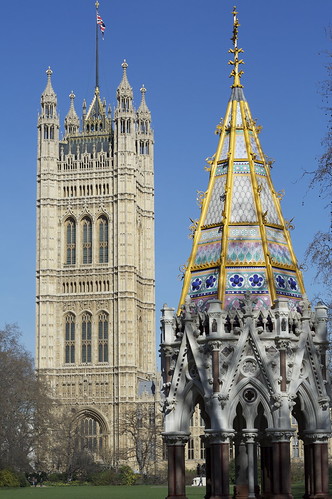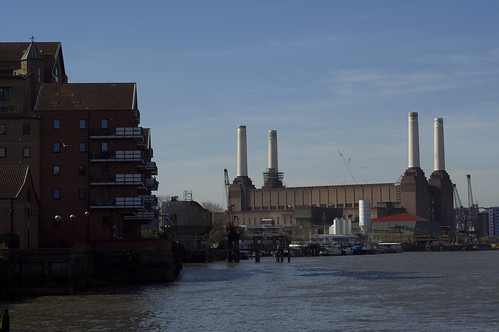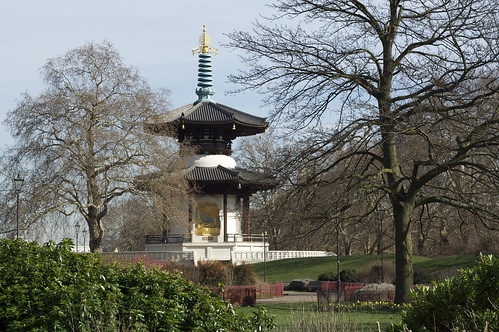I talked about the juxtaposition of the C19th Gothic of Tower Bridge and the genuine medievalness of the Tower of London: not, in my opinion, one of the great planning decisions in the history of London. Well, at Westminster, you meet with a similar case. The Palace of Westminster (i.e. the Houses of Parliament), started in 1840, sits over the road from Westminster Abbey, started six hundred years earlier in 1245, and does its best to insinuate that it’s been there all along.
The fact that this revival of a five-hundred-old style occurred in the throes of the Industrial Revolution is fascinating to me. And at a time when wealth was moving faster than ever from the hands of the landed gentry to industrialists and merchants, and when reform was broadening democracy and extending the franchise, the symbolism of choosing a parliament building in a style associated with feudalism and religion could keep the semioticians busy for weeks.

But symbolism aside, the finished result is far more successful than the Bridge/Tower combination. It helps that there’s a historical logic to it; it was after all built to replace the original medieval Palace of Westminster that burnt down in the 1830s, and it incorporates the medieval Westminster Hall. A lot of Victorian Gothic looks very Victorian indeed, because of the materials used or because a few Gothic motifs have been sprinkled on an essentially C19th building. And that’s no bad thing: much more interesting to reinvent a style for a new age than produce slavish reproductions. But in this case, given the location, I think it’s quite fitting that it does manage to look kind of ‘authentically’ medieval. Compared, for example, to the Buxton Memorial fountain marking the abolition of the slave trade:

And if it slightly overshadows Westminster Abbey: well, it’s an important building. Having Parliament in a vast, grandiose, sprawling palace while the Prime Minister’s residence is an anonymous terraced townhouse must be better than the other way round.
Heading off along the river, the next major landmark is what I still think of as ‘the Tate’ but is now ‘Tate Britain’, thanks to Nicholas Serota’s empire-building and his ruthless crackdown on definite articles. And on the opposite side of the river, the building a friend of mine used to refer to as Ming the Merciless’s palace.

It is in fact the headquarters of the Secret Intelligence Service (MI6). I don’t know whether the architects were specifically asked for something that squats on the riverbank like a gigantic stony-faced toad, or if it just seemed appropriate. I remember reading once that it was supposed to look from air like the portcullis which is the symbol for the Palace of Westminster; thanks to Google Maps you can now see that it sort of slightly does.
The impact of it is somewhat diluted now by the presence just over the bridge of St George Wharf, the ugliest building in London. I remember quite liking St George Wharf when it was first built; during my lifetime, London (and indeed the UK) hasn’t always felt like a forward-looking, self-confident kind of place, and a boom in constructing big shiny new buildings was quite exciting in and of itself. But it just looks uglier every time I see it. I can’t think of a single nice thing to say about it. And St George Wharf itself is soon going to be overlooked by a 49-storey tower built by the same company. Yay. Vauxhall wasn’t exactly a site of outstanding architectural beauty before the developers got there, mind you.
Anyway, I crossed over Vauxhall Bridge because I wanted to do the next bit of the walk on the south side of the river; mainly because I wanted to go past London’s favourite white elephant, Battersea Power Station. I guess BPS isn’t very well known outside London except to Pink Floyd fans, but it’s an old friend to Londoners, particularly those who regularly take the train into Victoria from south London. It was designed by Giles Gilbert Scott, who also designed the Bankside Power Station which now houses Tate Modern. The building is protected because of its architectural importance, and since it stopped producing electricity in the 80s, a sequence of developers have supposedly been converting it to some other use (theme park, shopping centre, whatever). The cynical theory is that their plan is to let it deteriorate to the point where eventually the government lets them knock it down and stick up a load of apartment buildings.

It was first built as a long narrow building with a chimney at each end (picture), and I actually think it was a more attractive building like that; elegant and cathedral like. But it was expanded in the 50s with a second turbine hall alongside the first, giving it its current upside-down table/dead dog look. Still, even if it messed up the proportions, it also made it much more striking and memorable. And if an impressive-but-ugly building sticks around for long enough, it eventually becomes much-loved. People even have nice things to say about the Albert Memorial.
As it turns out, you can’t see the Power Station especially well from the Thames Path anyway; the path cuts inland to go around the Power Station site and the site is surrounded by hoardings that largely obscure it. You’d probably get a better overall view from the other side of the river. Still, it was quite interesting; it goes past the market at Nine Elms, where the wholesale fruit and flower markets moved when Covent Garden was converted to a tourist trap; some nice houseboats, including one which, in what I thought was a particularly stylish touch, had a lawn on the deck; a recycling processing plant; and then Battersea Park, which was really very nice on a sunny day. The park has all sorts of different areas, but where the path goes it’s laid out in little elaborately shaped flower beds surrounded by iron fencing and looks, to my eyes, like a very classic Victorian city park; oddly enough it made me think of Paris. It’s also the site of the London Peace Pagoda, a distinctly random but quite attractive feature added in the 80s.

Then I went back over the river across the Albert Bridge. I think this might be the most attractive bridge in London. It’s nowhere near as striking as Tower Bridge, but it’s a lot prettier, with its decorative metalwork painted white and picked out in pale blue, pink and pistachio. It’s frothy and whimsical. The signs reading ‘All troops must break step when marching over this bridge’ only add to the sense of delicate lightness.
The walk then takes you through Chelsea, now of course one of the most expensive bits of London, but as recently as the late C19th it was louche and cheap enough to be where all the artists lived. The Hoxton of its time. Whistler did lots of paintings of Chelsea and Battersea, of course, and his is one of the many blue plaques that you pass on this section of the walk.
This is the last bit of the walk which takes you along the Thames Embankment. All the way from Blackfriars Bridge, in the City, to Battersea Bridge, there is a road that sweeps along the north bank of the Thames; it would give it a fine boulevardesque quality if it was a just a bit more pedestrian-friendly. In fact there’s too much traffic for it to really make a good place for a stroll; flâneurs should head for the South Bank or one of the parks. What’s not obvious is that it’s entirely built over a sewer; all the piss and shit of west London accumulates under there and is carried off downriver. It was one of the great civil engineering projects of C19th London, and put a stop not just to the regular cholera epidemics but the smell.
I can think of nothing interesting to say about Putney at all.
» These pictures and others can all be found in my Thames Path Flickr set. If you just want to see the ones from this section of the walk, they are tagged thamespath4. I’ve also posted some photos taken on the walk to my photoblog, Clouded Drab; they are tagged Thames Path.